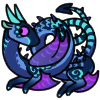@
Gubyub using different layer modes (You used one already- "Screen"!) can help you get interesting effects and interactions between the colors
The ones I use often are these:
Multiply - Good for adding a darker color (people use this a lot for shading)
Linear Burn - Not every program has this one, but its good for also adding shading. For this and multiply you should use a fairly light color to shade with, especially if you're shading something dark
Color Dodge - This is one of my favorites :] i use it for highlights all the time. For using this layer mode, I usually use a very dark brown, and it gives me a nice rich highlight. It's a lot like screen, but it calculates the colors a little bit differently. It's a little complicated to try and explain the difference, but over time youll get a feel for when each is appropriate :] Color dodge might also be missing some from programs. Linear Dodge is
not the same thing, but it can give a similar effect!
These, I find, are the most fundamental ones for most people who are starting to fiddle around with digital art, try noodling around and see what you can do with them :]! the best thing you can do is experiment, dont be afraid to search around your program, open up all of the little menus, theyre usually packed with useful stuff that people forgo cuz they just dont know about it!
ALSO significant for layer usage-
CLIPPING MASKS!
You can Clip a layer to another layer or alpha lock a layer to make it so you dont draw outside of the opacity that already exists- there are different ways to do this depending on the program youre using, but a safe bet is usually to right click the layer and look at the menu that comes up (there are also SEVERAL useful things on these!) and see if it has a "Clip to layer below" ("Merge" to layer below will, as it says, merge your layers. This is typically not ideal LOL but again, can be useful circumstantially) Try that with some layer modes above it, and see if it helps you understand better :]
Alpha lock is similar, but it locks the opacity of a single layer. It usually looks like a little checkerboard icon with a lock on it, and it usually hangs out in the "Layer" menu around the top (or where the other buttons are, theres usually a lock, to lock the layer so you cant modify it anymore but can still see it, and theres also sometimes an eye at the top that turns on / off all of the layers. it can really vary by program!)
Also- just a tip, after you sketch, turn down your sketch layers opacity to like 20-30% :] not only does this make it a Lot easier to line, but it also makes it so you can't draw on the wrong layer without knowing (the color will look strange)
if you still struggle, after you finish a layer you can put an *extra* blank layer between the layers youre working on, so you don't accidentally merge them, but i find this can clutter my layers kind of fast! depends on who you are :]
i hope something in here is at least a little helpful!!
Good luck!!
Edit:
okay p.s. i cannot resist saying- it might be a little bit advanced for where youre at right now, but the lasso tool in combination with the airbrush is
extremely powerful if you can learn how to use it right :] dont let this trip you up if youre finding its more difficult than what youre doing right now, but if youre struggling with controlling your airbrush a lasso tool could help!



















